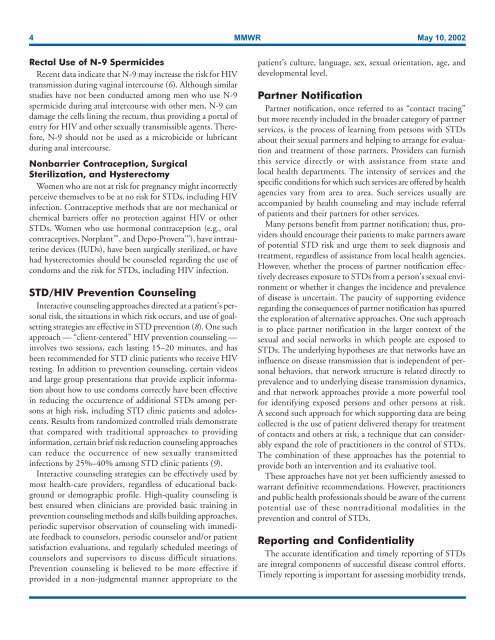You also want an ePaper? Increase the reach of your titles
YUMPU automatically turns print PDFs into web optimized ePapers that Google loves.
4 MMWR May 10, 2002<br />
Rectal Use of N-9 Spermicides<br />
Recent data indicate that N-9 may increase the risk for HIV<br />
transmission during vaginal intercourse (6). Although similar<br />
studies have not been conducted among men who use N-9<br />
spermicide during anal intercourse with other men, N-9 can<br />
damage the cells lining the rectum, thus providing a portal of<br />
entry for HIV and other sexually transmissible agents. Therefore,<br />
N-9 should not be used as a microbicide or lubricant<br />
during anal intercourse.<br />
Nonbarrier Contraception, Surgical<br />
Sterilization, and Hysterectomy<br />
Women who are not at risk for pregnancy might incorrectly<br />
perceive themselves to be at no risk for STDs, including HIV<br />
infection. Contraceptive methods that are not mechanical or<br />
chemical barriers offer no protection against HIV or other<br />
STDs. Women who use hormonal contraception (e.g., oral<br />
contraceptives, Norplant , and Depo-Provera ), have intrauterine<br />
devices (IUDs), have been surgically sterilized, or have<br />
had hysterectomies should be counseled regarding the use of<br />
condoms and the risk for STDs, including HIV infection.<br />
STD/HIV Prevention Counseling<br />
Interactive counseling approaches directed at a patient’s personal<br />
risk, the situations in which risk occurs, and use of goalsetting<br />
strategies are effective in STD prevention (8). One such<br />
approach — “client-centered” HIV prevention counseling —<br />
involves two sessions, each lasting 15–20 minutes, and has<br />
been recommended for STD clinic patients who receive HIV<br />
testing. In addition to prevention counseling, certain videos<br />
and large group presentations that provide explicit information<br />
about how to use condoms correctly have been effective<br />
in reducing the occurrence of additional STDs among persons<br />
at high risk, including STD clinic patients and adolescents.<br />
Results from randomized controlled trials demonstrate<br />
that compared with traditional approaches to providing<br />
information, certain brief risk reduction counseling approaches<br />
can reduce the occurrence of new sexually transmitted<br />
infections by 25%–40% among STD clinic patients (9).<br />
Interactive counseling strategies can be effectively used by<br />
most health-care providers, regardless of educational background<br />
or demographic profile. High-quality counseling is<br />
best ensured when clinicians are provided basic training in<br />
prevention counseling methods and skills building approaches,<br />
periodic supervisor observation of counseling with immediate<br />
feedback to counselors, periodic counselor and/or patient<br />
satisfaction evaluations, and regularly scheduled meetings of<br />
counselors and supervisors to discuss difficult situations.<br />
Prevention counseling is believed to be more effective if<br />
provided in a non-judgmental manner appropriate to the<br />
patient’s culture, language, sex, sexual orientation, age, and<br />
developmental level.<br />
Partner Notification<br />
Partner notification, once referred to as “contact tracing”<br />
but more recently included in the broader category of partner<br />
services, is the process of learning from persons with STDs<br />
about their sexual partners and helping to arrange for evaluation<br />
and treatment of those partners. Providers can furnish<br />
this service directly or with assistance from state and<br />
local health departments. The intensity of services and the<br />
specific conditions for which such services are offered by health<br />
agencies vary from area to area. Such services usually are<br />
accompanied by health counseling and may include referral<br />
of patients and their partners for other services.<br />
Many persons benefit from partner notification; thus, providers<br />
should encourage their patients to make partners aware<br />
of potential STD risk and urge them to seek diagnosis and<br />
treatment, regardless of assistance from local health agencies.<br />
However, whether the process of partner notification effectively<br />
decreases exposure to STDs from a person’s sexual environment<br />
or whether it changes the incidence and prevalence<br />
of disease is uncertain. The paucity of supporting evidence<br />
regarding the consequences of partner notification has spurred<br />
the exploration of alternative approaches. One such approach<br />
is to place partner notification in the larger context of the<br />
sexual and social networks in which people are exposed to<br />
STDs. The underlying hypotheses are that networks have an<br />
influence on disease transmission that is independent of personal<br />
behaviors, that network structure is related directly to<br />
prevalence and to underlying disease transmission dynamics,<br />
and that network approaches provide a more powerful tool<br />
for identifying exposed persons and other persons at risk.<br />
A second such approach for which supporting data are being<br />
collected is the use of patient delivered therapy for treatment<br />
of contacts and others at risk, a technique that can considerably<br />
expand the role of practitioners in the control of STDs.<br />
The combination of these approaches has the potential to<br />
provide both an intervention and its evaluative tool.<br />
These approaches have not yet been sufficiently assessed to<br />
warrant definitive recommendations. However, practitioners<br />
and public health professionals should be aware of the current<br />
potential use of these nontraditional modalities in the<br />
prevention and control of STDs.<br />
Reporting and Confidentiality<br />
The accurate identification and timely reporting of STDs<br />
are integral components of successful disease control efforts.<br />
Timely reporting is important for assessing morbidity trends,


